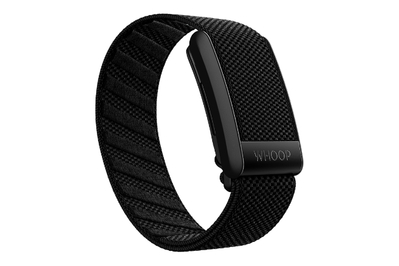
Who it’s for: This model is a good choice for people who want to track both sleep and workouts and don’t mind inputting a lot of data into the app.
How it works: This low-profile, screenless, woven wristband tracker uses photoplethysmography (PPG, used to detect blood-volume levels) and LEDs to shine a light on your skin. The Whoop then translates the differences in light (absorption and reflection) into changes in blood flow, which is how it calculates heart rate and heart-rate variability. The Whoop strap also uses an accelerometer to track motion. The accelerometer, the PPG, and Whoop’s “trademarked algorithm” make it possible for the tracker to determine your sleep stages.
It offers accurate sleep and heart-rate data. The Whoop 4.0’s heart-rate tracking closely aligned with the heart-rate sensor we used for comparison, though not quite as closely as the Oura Ring’s did.
Our testers reported that the Whoop 4.0 was accurate as a sleep tracker, as well. “I’ve tried nearly every fitness device,” said our most physically active tester. “Whoop has been the absolute best when it comes to sleep tracking.” Compared with other trackers, the Whoop more frequently sensed the correct time our tester went to bed and woke up. That same tester noted that one morning, despite counting eight hours of sleep according to her clock, she still felt tired. Whoop’s app confirmed that she was low on REM sleep and needed more recovery.
In Whoop’s own validation study, the device correctly captured the time spent in various stages 64% of the time, compared with a polysomnography test.
It offers in-depth activity and recovery tracking. The Whoop system tracks more fitness-related metrics than the Oura Ring does. Every morning, you receive a “recovery score,” which aims to show how prepared you are to tackle another day or workout. Whoop asks you to input your exercise sessions, such as cycling or jogging, directly; it then measures the activity’s strain, via heart-rate detection, to make recommendations, often in painstaking detail. For example, the app might tell you that you were in “Zone 3” during a workout, meaning you had hit 70% to 80% of your maximum heart rate. Our testers said that data like this helped them learn, in real time, if they were making strides in their fitness or overdoing it.
It’s comfortable and versatile to wear. Our testers found that the lightweight, woven Whoop wristband was comfortable to wear all day and during sleep. (In fact, I often forgot to take it off before hopping in the shower.) Though it isn’t as inconspicuous as the Oura Ring, the Whoop strap blended in with outfits more easily than the bulkier Apple Watch Series 8. Some testers liked that they could wear it on their bicep during workouts, and it would still collect data.
Flaws but not dealbreakers
It’s labor intensive. The Whoop app requires you to keep a daily journal on a host of factors, including how much alcohol or caffeine you consumed or the type of activity you engaged in (jogging or cycling, for example). You can’t opt out; the Whoop app won’t process your daily scores until you do it. Some of our testers found that the daily-journal requirement kept them aware of their habits and helped the Whoop system deliver better analyses. But others found it onerous and preferred the Oura Ring’s more passive interface.
It isn’t particularly stylish. Even though the Whoop band comes in numerous colors and patterns, it looks more like an athletic band than a stylish accessory.
The interface can be intimidating. Whoop’s interface isn’t as approachable as those of the other sleep trackers we tested, and its language takes some getting used to. Its app focuses more on performance and recovery, rather than energy and rest, and is peppered with terms such as “stress,” “strain,” and “impact analysis,” so using it can feel more like having a personal trainer than an encouraging gym buddy.
It’s also more difficult to access guidance in the Whoop app than in the Oura app. For example, if your REM and deep sleep account for less than 35% of your total time in bed, the app suggests that you consult a Whoop Coach (powered by AI) to learn how to improve instead of offering suggestions freely.
It has the most expensive subscription plan. Whoop doesn’t charge for its wristband, but to use it, you have to sign up for a $239 annual subscription (or $399 for two years).
- Subscription cost: $239 (one year), $399 (two years)
- Battery life: up to five days
- Water resistance: water resistant for up to two hours down to 32 feet of water
- Warranty: lifetime
- Privacy: Whoop never sells your personal data. All data captured in the device and app is encrypted. For details, read more about Whoop’s privacy policy.





